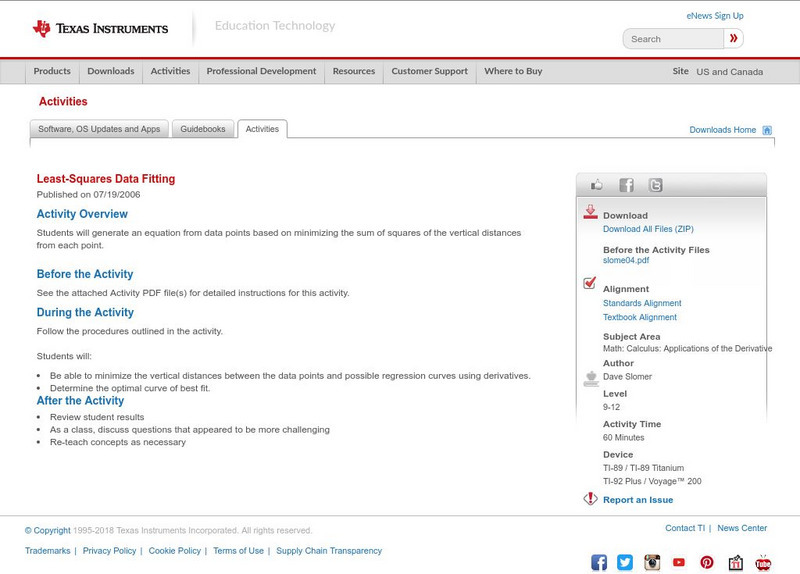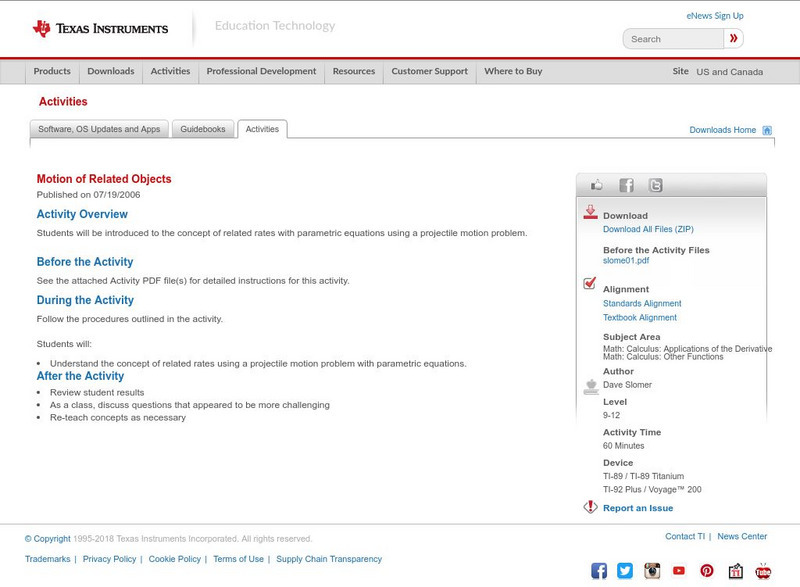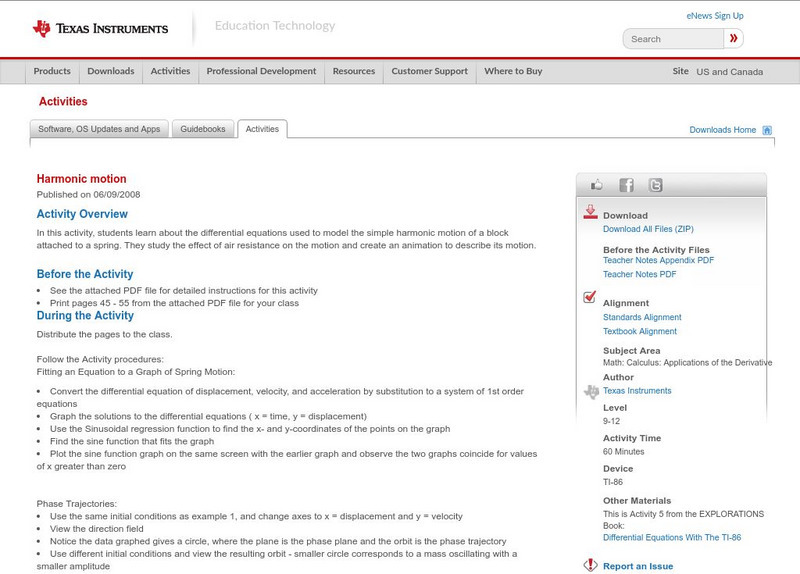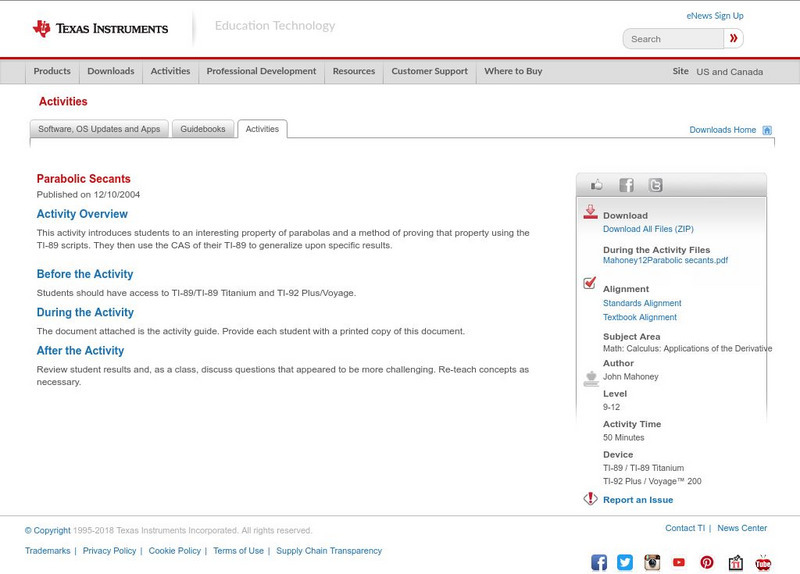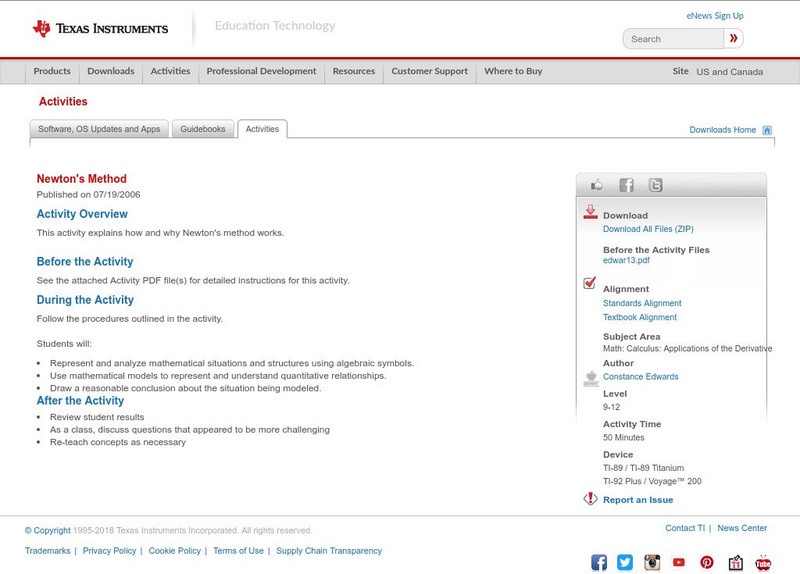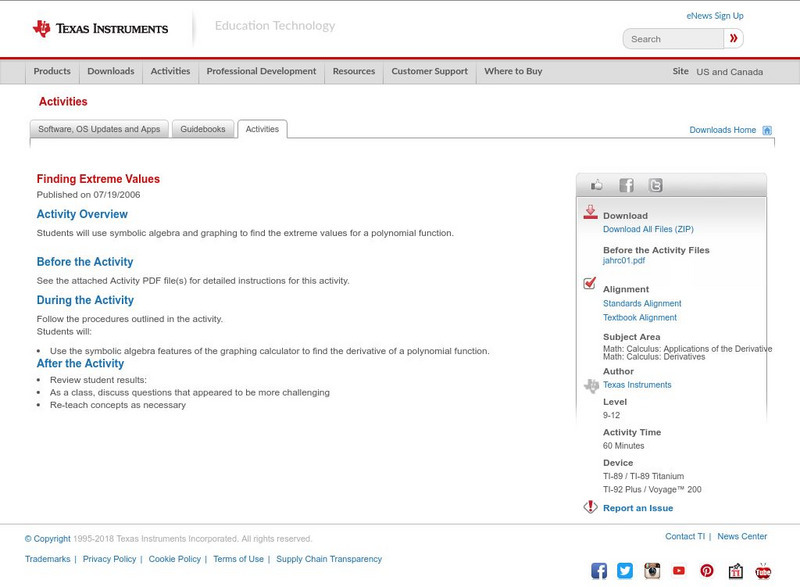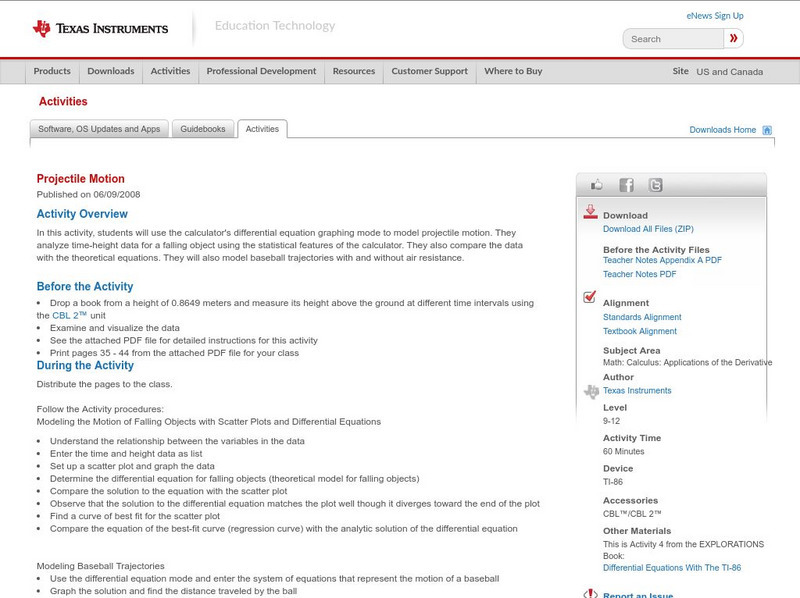Texas Instruments
Texas Instruments: Parametric, Vector, Polar and 3 D Functions
In this activity, students investigate and graph parametric functions, vectors, polar functions, and 3D functions.
Texas Instruments
Texas Instruments: Least Squares Data Fitting
This activity will allow the student to generate an equation from data points based on minimizing the sum of squares of the vertical distances from each point.
Texas Instruments
Texas Instruments: Managing the National Debt
In this activity, the students will predict the national debt by using logistic growth. The students will find the current national debt and use it to make their predictions.
Texas Instruments
Texas Instruments: Approximate Solutions: Differential Equations
The base of the natural logarithm function, is called Euler's number, in honor of Leonhard Euler, a great Swiss mathematician. (Continued. See "before the activity.")
Texas Instruments
Texas Instruments: Motion of Related Objects
This activity introduces the concept of related rates with parametric equations using a projectile motion problem.
Texas Instruments
Texas Instruments: Harmonic Motion
In this activity, students learn about the differential equations used to model the simple harmonic motion of a block attached to a spring. They study the effect of air resistance on the motion and create an animation to describe its...
Texas Instruments
Texas Instruments: Parabolic Secants
This activity introduces students to an interesting property of parabolas and a method of proving that property using the TI-89 scripts. They then use the CAS of their TI-89 to generalize upon specific results.
Texas Instruments
Texas Instruments: Newton's Method
This activity explains how and why Newton's method works.
Texas Instruments
Texas Instruments: Optimization
This activity shows the student how to determine the optimal solution for maximum volume based on the box-with-no-top problem.
Texas Instruments
Texas Instruments: Mean Value Theorem
The student will be able to understand the Mean Value Theorem using numerical and graphical methods.
Texas Instruments
Texas Instruments: Finding Extreme Values
In this activity, students can use symbolic algebra and graphing to find the extreme values for a polynomial function.
Texas Instruments
Texas Instruments: Projectile Motion
In this activity, students can use the calculator's differential equation graphing mode to model projectile motion. They analyze time-height data for a falling object using the statistical features of the calculator. They also compare...
CK-12 Foundation
Ck 12: Tangent Lines
[Free Registration/Login Required] Students can adjust the size of the circle to explore the tangent lines. Click learn more to watch a video and click challenge me to answer a practice question.
Other
American Mathematical Society: Bin Packing
Bin packing is a very appealing mathematical model. This article discusses several bin packing problems and the various methods for solving them.
Other
European Journal of Operational Research: Two Dimensional Packing Problems
This article analyzes problems requiring to allocate a set of rectangular items to larger rectangular standardized units by minimizing the waste. It discusses mathematical models and surveys lower bounds, classical approximation...
Other
Science Direct: Recent Advances on Two Dimensional Bin Packing Problems
This paper surveys recent advances obtained for the two-dimensional bin packing problem, with special emphasis on exact algorithms and effective heuristic and metaheuristic approaches.
Interactive Mathematics
Interactive Mathematics: Newton's Method
This lesson provides an example demonstrating the iterative method of finding the roots of a function using derivatives.
Interactive Mathematics
Interactive Mathematics: Curve Sketching
Sketches of functions are drawn by determing important points: x- and y-intercepts, local maxima and minima, and point of inflection. The general shapes of specific functions are illustrated to help identify characteristics of each type...
Department of Defense
Do Dea: Working With Parabolic Projectile Paths
Using the free-fall constants and gravity acceleration equations, we can determine many things about the position, velocity, and speed of a projectile. Here are a few examples and explanations. This is a great review for the AP Calculus...
Department of Defense
Do Dea: Normal Line to a Curve
The tangent to a curve is always found at a certain point along the curve. Often you will be asked to find the normal to a curve at a point. View an example on this site.
Department of Defense
Do Dea: Free Fall Constants for Earth
When you work with equations that show position, velocity, acceleration of objects that are flying or falling through the air, you will be using the constant that is the acceleration due to gravity. View formulas, explanations, and...
Massachusetts Institute of Technology
Mit: Calculus Index
This site from the Massachussets Institute of Technology has links to various topics in calculus.
Shodor Education Foundation
Shodor: Gas Laws
An excellent site for understanding and applying the ideal gas law. The combined and other variations of the ideal gas law are derived. There are sample application problems with an abbreviated method of solving the problems.
OpenStax
Open Stax: College Physics: Bernoulli's Equation
Learn all about Bernoulli's principle in this section. Explore the definition, how to calculate, how to derive, and applications of Bernoulli's equation. Section also includes problems and questions for the students to answer to ensure...

